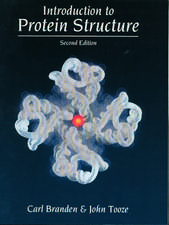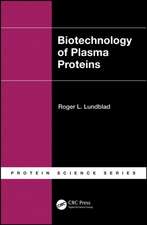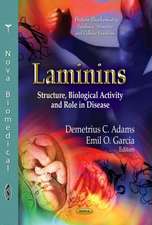Handbook of Proteomic Methods
Editat de P. Michael Connen Limba Engleză Paperback – 5 noi 2010
| Toate formatele și edițiile | Preț | Express |
|---|---|---|
| Paperback (1) | 1228.44 lei 6-8 săpt. | |
| Humana Press Inc. – 5 noi 2010 | 1228.44 lei 6-8 săpt. | |
| Hardback (1) | 1253.42 lei 6-8 săpt. | |
| Humana Press Inc. – 10 iul 2003 | 1253.42 lei 6-8 săpt. |
Preț: 1228.44 lei
Preț vechi: 1498.10 lei
-18% Nou
Puncte Express: 1843
Preț estimativ în valută:
235.10€ • 244.80$ • 198.69£
235.10€ • 244.80$ • 198.69£
Carte tipărită la comandă
Livrare economică 07-21 martie
Preluare comenzi: 021 569.72.76
Specificații
ISBN-13: 9781617375040
ISBN-10: 1617375047
Pagini: 528
Ilustrații: XIV, 510 p. 136 illus., 7 illus. in color.
Dimensiuni: 178 x 254 x 28 mm
Greutate: 0.91 kg
Ediția:Softcover reprint of hardcover 1st ed. 2003
Editura: Humana Press Inc.
Colecția Humana
Locul publicării:Totowa, NJ, United States
ISBN-10: 1617375047
Pagini: 528
Ilustrații: XIV, 510 p. 136 illus., 7 illus. in color.
Dimensiuni: 178 x 254 x 28 mm
Greutate: 0.91 kg
Ediția:Softcover reprint of hardcover 1st ed. 2003
Editura: Humana Press Inc.
Colecția Humana
Locul publicării:Totowa, NJ, United States
Public țintă
ResearchCuprins
General Techniques.- Proteomics and the Molecular Biologist.- Protein Identification from 2-D Gels Using In Vitro Transcription Translation Products.- Selective Chemical Cleavage Methods in Proteomics, Including C-Terminal Successive Degradation.- Means of Hydrolyzing Proteins Isolated upon ProteinChip® Array Surfaces.- A Combined Radiolabeling and Silver Staining Technique for Improved Visualization and Localization of Proteins on Two-Dimensional Gels.- Qualitative and Quantitative Proteomic Analyses via Multidimensional Protein Identification Technology.- Di- and Tri-Chromatic Fluorescence Detection on Western Blots.- Multiplexed Proteomics.- A Strategy for Characterizing Antibody/Antigen Interactions Using ProteinChip® Arrays.- Stable Isotope Labeling with Amino Acids as an Aid to Protein Identification in Peptide Mass Fingerprinting.- The Use of 18O Labeling as a Tool for Proteomic Applications.- Automated Nanoflow Liquid Chromatography/Tandem Mass Spectrometric Identification of Liver Mitochondrial Proteins.- In Silico Proteomics.- Post-Translational Modifications, Variants, and Isoforms.- Predicting Glycan Composition from Experimental Mass Using GlycoMod.- Querying GlycoSuiteDB.- New Tools for Quantitative Phosphoproteome Analysis.- Computer-Aided Strategies for Characterizing Protein Isoforms.- Protein Variant Separations Using Cation Exchange Chromatography on Grafted, Polymeric Stationary Phases.- Specific Systems.- Noninvasive Imaging of Protein-Protein Interactions in Living Animals.- Strategies in Clinical Proteomics.- Proteomic Profiling of the Cancer Microenvironment.- Identification of Determinants of Sensitivity to Antitumor Drugs.- Application of Proteomics to the Discovery of Serological Tumor Markers.- Infectomic Analysis of Microbial InfectionsUsing Proteomics.- Toward a Complete Proteome of Bacillus subtilis.- Renal and Urinary Proteomics.- Proteomics in Endocrinology.- Proteomics in Plant Biology.- Data Analysis.- Bioinformatics in Proteomics.- Quantitative Characterization of Proteomics Maps by Matrix Invariants.- Complexity of Protein-Protein Interaction Networks, Complexes, and Pathways.- Patchwork Peptide Sequencing.- Estimation of Bias in Proteome Research.- Scoring Functions for Mass Spectrometric Protein Identification.
Recenzii
"...covers recent advances and also acts as a manual of well-practiced techniques. This volume should appeal particularly to the uninitiated but contains several articles of interest to more experienced practitioners...As well as being an excellent guide, this volume in its entirety makes a strong case for the advantages in the application of these post-genomic technologies" - Rapid Communications in Mass Spectrometry
"Handbook of Proteomic Methods includes a wide range of techniques for identifying and analyzing proteins expressed in cells. As many other Humana Press method books, this is another must-have for large academic libraries supporting research in complex biological systems and drug development." -E-STREAMS
"This is a very well produced volume with excellent diagrams and reproduction of difficult images such as 2-D gels...deserves a place on the proteomic researchers' bookshelf." - Chromatographia
"Handbook of Proteomic Methods includes a wide range of techniques for identifying and analyzing proteins expressed in cells. As many other Humana Press method books, this is another must-have for large academic libraries supporting research in complex biological systems and drug development." -E-STREAMS
"This is a very well produced volume with excellent diagrams and reproduction of difficult images such as 2-D gels...deserves a place on the proteomic researchers' bookshelf." - Chromatographia
Textul de pe ultima copertă
The developing new field of proteomics holds significant promise for a deeper understanding of complicated biological systems, as well as for novel approaches to the cure of disease. In the Handbook of Proteomic Methods, P. Michael Conn has assembled a panel of well-recognized experts to describe a wide range of powerful techniques for identifying and analyzing the diversity of proteins expressed in cells. These readily reproducible proteomic methods range from general to specific techniques, and include methods for data analysis, post-translational modification, and its variants and isoforms. Additional methods demonstrate the application of proteomics to the discovery of serological tumor markers, to identifying the determinants of sensitivity to antitumor drugs, and to specialized fields, such as endocrinology, plant biology, nephrology, and urology. Each fully tested protocol is described in step-by-step detail, complete with tricks of the trade and hints on avoiding pitfalls. The detail of description exceeds that usually found in primary publications.
Wide-ranging and practical, the Handbook of Proteomic Methods offers scientists entering, or already active in, the field a fully referenced compendium of easy-to-use proteomic methods-each reflecting the power and promise of proteomics in illuminating complex biological systems and in promoting the development of novel drugs for the amelioration of disease.
Wide-ranging and practical, the Handbook of Proteomic Methods offers scientists entering, or already active in, the field a fully referenced compendium of easy-to-use proteomic methods-each reflecting the power and promise of proteomics in illuminating complex biological systems and in promoting the development of novel drugs for the amelioration of disease.
Caracteristici
Includes supplementary material: sn.pub/extras















